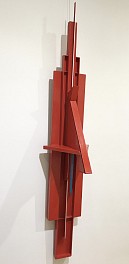BIOGRAPHY

American (1911-1984)
Seymour Fogel was an American artist whose artistic output included social realist art early in the century, abstract art and expressionist art at mid-century, and constructivist art late in the century. His drive to experiment led him to work with expected media – oil paints, watercolors, and acrylics – as well as unconventional media such as glass, plastics, sand, wood and wax.
Fogel began his studies at the Art Students League and the National Academy of Design. In 1933, he worked as an assistant to Diego Rivera on his ill-fated Man at the Crossroads Looking with Hope and High Vision to the Choosing of a New and Better Future mural at Rockefeller Center. Nelson Rockefeller ordered it covered up due to its Communist references. Nevertheless, Fogel not only learned the art of mural painting and the labor-intensive technique of buon fresco from Rivera but also Rivera’s method of creating art accessible to the masses by infusing the decorative with the didactic. His experience as a mural painter would inform his work thoughout his career.
In 1946, he moved to Austin to teach. Indeed, he is known as the "Father of Texas Modernism". The move to Austin marked a new era of exploration of modernist abstraction for Fogel. As he methodically worked through the formal challenges of abstraction, he created several series inspired by Picasso, Mondrian, and other modern masters. He was not the first to create these kinds of works, but his work was thoughtful and considered. He was, says one critic, "a perfector of forms."
Fogel was peripatetic in his media, his exploration of genres and in terms of where he lived. He returned to New York and began experimenting with the neo-constructivism of Mondrian, of which this wall sculpture is an example. He had always been interested in architecture, and his architectural, totemic wall sculptures have an architectural feel to them.
His work can be found in the collections of the Whitney, the Hirshorn Museum, the Dallas Museum of Art and the Telfair Museum.
